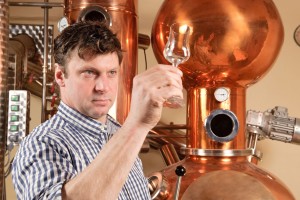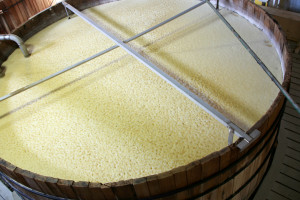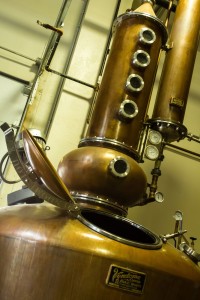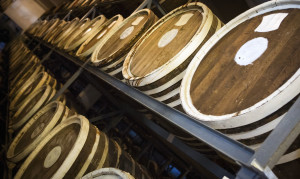Field to Glass… The Re-emergence of the American Farm Distillery – by Elizabeth Miller, CSW, CSS
Estate-bottled. Terroir. In the wine world these have long been terms that evoke respect for certain bottles and fetch higher prices. It’s significantly less typical to see an estate bottled spirit, where all the variables of production occur in the same location… until recently! Thanks to the reemergence of the farm distillery, gazing out from the distillery tasting room on a field of grains is now a more common experience for the spirits lover.
The movement goes by many names: grain to bottle, farm to glass, field to bottle. Whichever the term, distilleries are now embracing farming and producing real land-based products.
Every bottle starts at the beginning: the base ingredient. If you are a distiller in the United States or a famous whiskey producing country like Scotland and Ireland, you likely do not grow your own base ingredients or even source it close to your distillery. You say to your broker, “I need this grain, or that botanical.” The farm distillery eliminates that degree of separation.
However, at Coppersea Distillery in Ulster County, New York, fallow and weed-choked pastures have been reclaimed for grains that produce their corn, bourbon, rye and barley whiskey. We really shouldn’t be surprised! The farm distillery is the natural outgrowth of the craft distilling renaissance. It’s becoming difficult to choose from the explosion of spirits choices at your favorite bar or retailer. Favorable state legislation plus a powerful locavore movement has produced a boom in distilling licenses throughout the country. Of those new craft distilleries, the American Distilling Institute found over 10% now are farm distilleries that either grow their own base ingredients or source them from local farms.
While the farm distillery seems new, it’s really a return to the beginning. Long before the first American commercial whiskey distillery was founded in 1783 in Louisville, Kentucky, farmers were finding extra profits in their grains. European colonists had arrived to America with the practice of whiskey making, and distilling bumper crops was both profitable and efficient. The spirits could be stored almost indefinitely and it was easier to store and transport compared to enormous bales of grain.
Breadbasket regions became home to hundreds and hundreds of distilleries. In New York, where more than 1 million bushels of barley were being harvested in the 19th century, over 1000 farm distilleries flourished. Prohibition, however, ended this era, and the breadbasket regions of American ran dry… until today. The Staley Mill Farm & Distillery in New Carlisle, Ohio—family owned since 1818—ran their handmade copper still long before Prohibition. In the next few years, their 160-acre farm will yield organic corn and rye to fully supply their resurrected distillery.
The farm distillery is not the easy street. There are substantial time and financial investments in purchasing seeds, field conditioning and procuring equipment. Carefully planned harvesting, drying practices, finely calibrated humidity control, storage and transportation are all crucial to the final product and the bottom line – but the risks are worth it!
A farmer distiller has complete creative control, and can introduce something previously attributed only to wine: terroir. Dave Pickerell, formerly Master Distiller at Maker’s Mark and Whistle Pig, is currently with Hillrock Estate Distillery in the Hudson Valley Highlands where 100 estate-owned grain fields surround the craft distillery. In the Whiskey Advocate in 2010, Pickerell wrote of the uniform expression of whiskey by most of the major distillers, who all buy commodity grain. His vision of the future includes “new expressions of whiskey… representing a new sort of terroir, where true geographical differences in the U.S. can not only be expressed but also clearly differentiated.”
Spirits lovers can expect a continued deeper connection to the land in their bottles, from one corner of the United States to another. In Colorado’s North Fork Valley, the Jack Rabbit Hill and Peak Spirits farm and distillery is practicing biodynamic farming. The Barber family celebrates six generations on their 158 year-old farm in Schoharie Valley, New York. Their distillery turns out their 1857 Vodka from not only their own potatoes but also the property’s spring water. Estate owned malt houses and the propagation of heirloom grains are just a few perks we should expect from the growing farm distillery movement.
The next time we open a bottle, we can expect so much more, thanks to the reemergence of farm distilleries. We can expect the taste of history, the taste of America and true taste of fields of grain.
Elizabeth Miller is the General Manager of Vintology Wine & Spirits and the Associate Director the Westchester Wine School in Westchester County, NY. She has very happily traveled extensively throughout New York State visiting farm and urban distilleries. Her blog ‘Girl Meets Vine’ is found at http://www.elizabethmillerwine.com/girlmeetsvine.




Pingback: Field to Glass – The Re-emergence of the American Farm Distillery – Westchester Oenophile